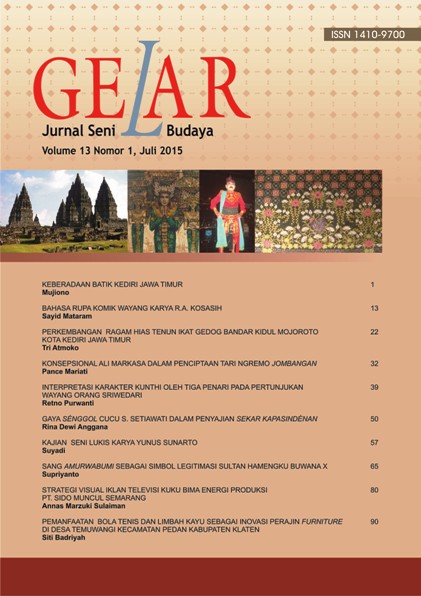KONSEPSIONAL ALI MARKASA DALAM PENCIPTAAN TARI NGREMO JOMBANGAN
Main Article Content
Abstract
Dance Ngremo Jombangan is one of the dances Ngremo in East Java that has a special characteristiccompared to other dance Ngremo. The dance is created by Ali Markasa, a pengreman (Ngremo dancer) fromJombang. Ali treats the movements in such a way that they are able to bring a technique of an attractive anddynamic movement in dance Ngremo Jombangan. The research aims to convey Ali Markasa’s concept increating dance Ngremo Jombangan. It uses the method of qualitative analysis descriptive with etnokoreologiapproach. The result shows that Ali Markasa wants to create dance Ngremo because of his experience as apengreman in Ludruk performance. He learns that the movement of dance Ngremo is common and spiritless.For the reason, he wants to create a dance Ngremo that is more attractive and dynamic called Dance NgremoJombangan. His creativity in dance ngremo is able to give a special characteristic. It can be seen in themovements of sadukan sampur, tanjak, and ayam alas. His technique of movements is dynamic and attractive.It is often known as njangkrik upo because of his agility in dancing.
Keywords: concept, Ali Markasa, dance Ngremo Jombangan
Downloads
Article Details
Copyright
Authors who publish with Gelar: Jurnal Seni Budaya agrees to the following terms:
- Authors retain copyright and grant the journal right of first publication with the work simultaneously licensed under a Creative Commons Attribution License (CC BY-SA 4.0) that allows others to share the work with an acknowledgment of the work's authorship and initial publication in this journal.
- Authors are able to enter into separate, additional contractual arrangements for the non-exclusive distribution of the journal's published version of the work (e.g., post it to an institutional repository or publish it in a book), with an acknowledgment of its initial publication in this journal.
- Authors are permitted and encouraged to post their work online (e.g., in institutional repositories or on their website) prior to and during the submission process, as it can lead to productive exchanges, as well as earlier and greater citation of published work.
